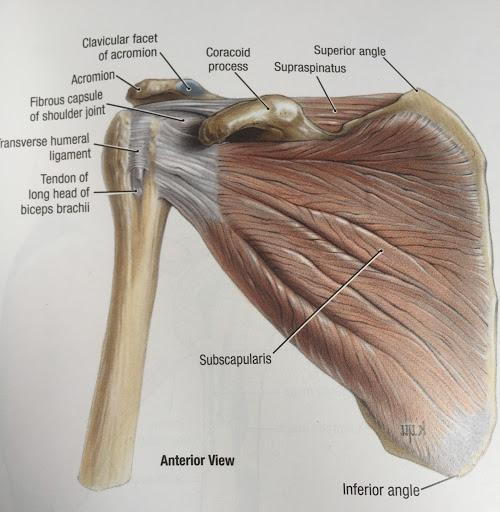Rotator Cuff
posted: Feb. 28, 2020.

What is the rotator cuff?
The rotator cuff is comprised of four muscles that surround the shoulder joint (head of humerus). These four muscles function to assist in moving the arm in various planes of motion, but are prone to injury with improper position of the scapula. The muscles include: supraspinatus, infraspinatus, teres minor, subscapularis (SITS).
Supraspinatus- Assists in elevating arm outward
Infraspinatus- Externally rotates arm
Teres minor- Externally rotates arm
Subscapularis- Internally rotates arm
Anatomy of the Shoulder
In effort to understand how injury to the rotator cuff happens, we need to look at the anatomy of the shoulder. The shoulder joint is comprised of the head of the humerus (arm) and the scapula (shoulder blade). The rotator cuff muscles attach from the scapula to the humeral head and assist with movement. It’s important to note two bony landmarks on the scapula: The acromion and the coracoid process. These two play a part in how injury may occur as described below.
Injury to Rotator Cuff
In my personal experience with treating this, I have never seen a complete tear to these tendons in anyone under 40 years old. This is likely because injury to the rotator cuff is usually due to repetitive stress OVER TIME. Injury to these muscles is usually in the form of microtrauma to the tendons (where muscles attach to the bone). This is where the acromion and coracoid process come into play.
Another muscle group called the pecs (pectoralis minor) will attach to the coracoid process. This muscle is chronically SHORTENED in almost EVERYONE I treat. The tightness of this muscle creates a downward pull on the coracoid process of the scapula, and DECREASES the space between the humeral head and the acromion. Weakness to mid back muscles (scapular stabilizers) also contributes to this decreased space.
So if the pecs are tight, and the mid back muscles are weak, the rotator cuff tendons are more prone to microtrauma, tendonitis, bursitis, tearing, strain, and “impingement” over time with ANY arm movement!
If you can picture what’s going on physically in this situation, it’s basically someone with rolled forward shoulders and POOR POSTURE. Someone in this position is not using proper musculature to stabilize the scapula through movement of the arm.
Imagine for example: you are painting over the weekend with a brush for hours and hours. You have to really reach to get into the hard to get places, so naturally your shoulder rolls forward to extend your arm further. If your arm is rolled forward (especially for extended time), you are putting excessive load to these rotator cuff muscles. If you use the stronger muscles of your back to assist in this movement, and stay in the proper position, there is much less stress on rotator cuff tendons (and more space for them).
Try This!
Try holding a 5-10lb weighted object in your hand with your arm straight out, purposefully in an extremely rolled forward (poor posture) position. Now try the same thing, but in proper posture with scapula pulled down/back using more of your back muscles. Do you feel stronger in this position? You should!
How to Fix
As mentioned above, a massive part of treating rotator cuff issues is to address someone’s posture. WAY EASIER SAID THAN DONE. Correct shoulder position will not come in a week, but focusing on strengthening the correct muscles (scapular stabilizers) and releasing (shoulder internal rotators) will start the process. This will take less load on the rotator cuff muscles, and give more space in the shoulder joint. A musculoskeletal specialist (Doctor of Chiropractic or Physical Therapist) would be able to assess, diagnose, and treat any shoulder injury. Ask your doctor if they have experience in treating rotator cuff and shoulder injuries.
Eccentric loading (lengthening a contracted muscle) will help build strength to the rotator cuff making them more resilient to fatigue.
I personally recommend using heat in effort to increase blood flow and oxygen to perfuse tissues in need. This will speed up healing time.
Foam rolling or releasing muscles involved.
Rotator Cuff Treatment at our Holland Chiropractic Clinic
At McAlpine Chiropractic Group we have years of experience with treating shoulder injuries in the Holland area. Active Release Technique (ART) would be performed to muscles that are bringing scapula into an improper position, as well as hypertonic rotator cuff muscles involved. Chiropractic adjustments would be performed to shoulders, and cervical and thoracic spine. Different modalities can be used to facilitate healing: ultrasound, E-stim, laser. Strengthening would be incorporated to assist in proper scapular movement.
If you are experiencing any type of shoulder discomfort, call McAlpine Chiropractic Group at 616-392-7031 for a consultation.
